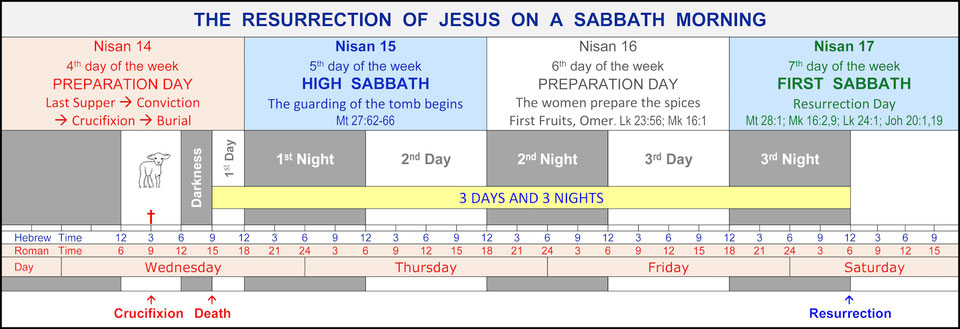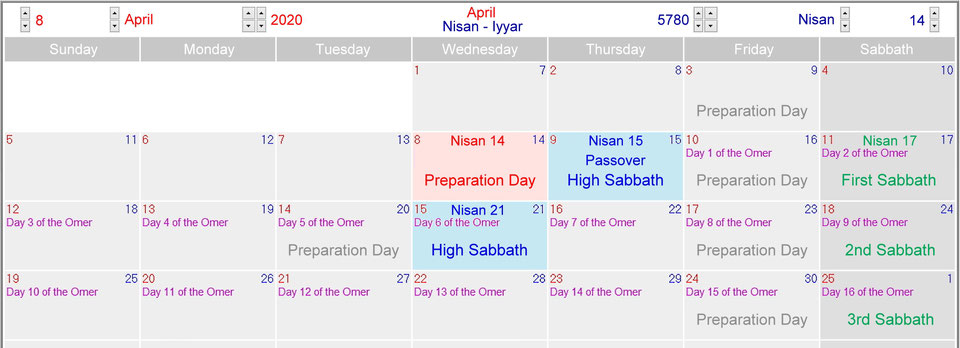Alan Gross
Well-Known Member
Definition: Pre-Sabbath, Preparation Day.
Apart from the Sabbath, only the day before the Sabbath was named in Israel
(Mt 27:62; Mk 15:42; Lk 23:54; Jn 19:14,31,42).
It was the Pre-Sabbath (προσαββατον = prosabbaton: Mk 15:42),
preparation day or pre-rest day or makeready day (Greek paraskeue,
derived from paraskeuazo: to get ready, to equip, to prepare, to arrange).
Mark used both terms in one sentence, literally:
"since it was the day of Preparation,
that is, the day before the Sabbath" (Mark 15:42).

The preparation day is the day before the Sabbath, the so-called pre-Sabbath.
Since there are preparation days for weekly Sabbaths
as well as preparation days for the seven annual High Sabbaths,
there are always several preparation days within only seven days
in the spring and autumn holiday weeks.
But if in one year a High Sabbath falls on a weekly Sabbath,
this "double Sabbath" has only one common preparation day.
There are 3 types of preparation days to be distinguished:
because Easter also has only one Sabbath (Saturday) before Easter Sunday;
but Passover has three Sabbaths.
And if there are three Sabbaths in the Feast,
then of course there must also be three days of preparation,
and either to the annual Sabbaths or to the minor weekly Sabbaths,
unless an annual Sabbath falls on a weekly Sabbath (i.e., always Saturday),
in which case there is a day of preparation to a double Sabbath.
So there are three types of preparation days
because there are three types of Sabbaths
(annual Sabbath, weekly Sabbath, double Sabbath).
Many study Bibles with Strong numbers of Greek words
define the day of preparation
as "the day before the weekly Sabbath (i.e. Friday)
OR the day before a feast (annual High Sabbath)".
However, most Christians are not aware that the Bible
does not say that Jesus died on the preparation day for a weekly Sabbath
(i.e. not on a Friday),
but on the pre-Sabbath for a major holiday
(festival, the first annual Sabbath, Passover on the 15th Nisan),
which can fall on different weekdays:
Jn 19:31 (KJV): "The Jews therefore, because it was the preparation,
that the bodies should not remain upon the cross on the sabbath day,
(for that sabbath day was an high day,) besought Pilate
that their legs might be broken, and that they might be taken away."
Since many Christians
cannot distinguish between weekly and annual Sabbaths,
they start from the false assumption that Jesus was crucified on a Friday.
But the Bible is only about the day before a high feast Sabbath.
John also tells us clearly
which of the seven major annual feast Sabbaths (holy days) it was,
namely: John 19:14 (KJV): "And it was the preparation of the passover..."
So it was about the preparation day for the first annual Sabbath,
the high Passover on the 15th of Nisan (Abib).
All scholars agree on this.
But they place theological tradition before the Word of God (Bible)
and have thus placed this feast day on a weekly Sabbath.
Astronomical data clearly prove:
In the year in which Jesus was crucified (30, 31 or 34 A.D.),
there was no double Sabbath,
but the preparation day (14th Nisan) fell on a Wednesday
and the following annual High Sabbath (15th Nisan) on a Thursday.
Jesus rose from the dead after "3 days and 3 nights".
That was "on the one of the Sabbaths" (Mk 16:2; Lk 24:1; Jn 20:1)
until Pentecost, namely "early on the first Sabbath" (Mk 16:9; 17th Nisan)
of the seven Sabbaths that are counted every year
until the feast of weeks (Shavuot, Pentecost):

The 3 preparation days and the 3 Sabbaths
during the Passover Feast and the Resurrection Sabbath.
All preparation days have one thing in common: just like the Sabbath,
they begin at sunset and end at the next sunset.
Therefore, the preparation day for a weekly Sabbath
is strictly speaking never the Friday,
but always the period from Thursday evening to Friday evening,
always after sunset.
The preparation day (14th Nisan) for the Passover (15th Nisan)
is called "Erev Pesach" by the Jews today, the evening before the Sabbath
(erev means the eve of Jewish festivals, i.e. the day of light after noon.

The two preparation days and the two Sabbaths
and the three days and three nights.
In 2020 the sequence of days at the Passover
was exactly the same as in the year Jesus was crucified.
There were once again three preparation days (Nisan 14, 16 and 20)
and three Sabbaths (Nisan 15, 17 and 21).
This sequence of days is very common according to the Jewish calendar
and occurs somewhat every third year:

The preparation days and Sabbaths
during the Passover Festival 2020 and the Resurrection Sabbath.
The sequence of events at the time of Jesus
on the preparation day, the 14th of Nisan:

The events on Nisan 14, the preparation day for the High Sabbath
- the Last Supper, condemnation, and crucifixion of Jesus.
Apart from the Sabbath, only the day before the Sabbath was named in Israel
(Mt 27:62; Mk 15:42; Lk 23:54; Jn 19:14,31,42).
It was the Pre-Sabbath (προσαββατον = prosabbaton: Mk 15:42),
preparation day or pre-rest day or makeready day (Greek paraskeue,
derived from paraskeuazo: to get ready, to equip, to prepare, to arrange).
Mark used both terms in one sentence, literally:
"since it was the day of Preparation,
that is, the day before the Sabbath" (Mark 15:42).

The preparation day is the day before the Sabbath, the so-called pre-Sabbath.
Since there are preparation days for weekly Sabbaths
as well as preparation days for the seven annual High Sabbaths,
there are always several preparation days within only seven days
in the spring and autumn holiday weeks.
But if in one year a High Sabbath falls on a weekly Sabbath,
this "double Sabbath" has only one common preparation day.
There are 3 types of preparation days to be distinguished:
- Preparation day for a weekly Sabbath, always Thursday evening until Friday evening
- Preparation day for an annual Sabbath (=high Sabbath, festive Sabbath), which can fall on any day of the week
- Preparation day for a double Sabbath, if an annual Sabbath (=high Sabbath, festive Sabbath, Feast) falls on a weekly Sabbath, always from Thursday evening to Friday evening. It would then be a "double preparation day".
because Easter also has only one Sabbath (Saturday) before Easter Sunday;
but Passover has three Sabbaths.
And if there are three Sabbaths in the Feast,
then of course there must also be three days of preparation,
and either to the annual Sabbaths or to the minor weekly Sabbaths,
unless an annual Sabbath falls on a weekly Sabbath (i.e., always Saturday),
in which case there is a day of preparation to a double Sabbath.
So there are three types of preparation days
because there are three types of Sabbaths
(annual Sabbath, weekly Sabbath, double Sabbath).
Many study Bibles with Strong numbers of Greek words
define the day of preparation
as "the day before the weekly Sabbath (i.e. Friday)
OR the day before a feast (annual High Sabbath)".
However, most Christians are not aware that the Bible
does not say that Jesus died on the preparation day for a weekly Sabbath
(i.e. not on a Friday),
but on the pre-Sabbath for a major holiday
(festival, the first annual Sabbath, Passover on the 15th Nisan),
which can fall on different weekdays:
Jn 19:31 (KJV): "The Jews therefore, because it was the preparation,
that the bodies should not remain upon the cross on the sabbath day,
(for that sabbath day was an high day,) besought Pilate
that their legs might be broken, and that they might be taken away."
Since many Christians
cannot distinguish between weekly and annual Sabbaths,
they start from the false assumption that Jesus was crucified on a Friday.
But the Bible is only about the day before a high feast Sabbath.
John also tells us clearly
which of the seven major annual feast Sabbaths (holy days) it was,
namely: John 19:14 (KJV): "And it was the preparation of the passover..."
So it was about the preparation day for the first annual Sabbath,
the high Passover on the 15th of Nisan (Abib).
All scholars agree on this.
But they place theological tradition before the Word of God (Bible)
and have thus placed this feast day on a weekly Sabbath.
Astronomical data clearly prove:
In the year in which Jesus was crucified (30, 31 or 34 A.D.),
there was no double Sabbath,
but the preparation day (14th Nisan) fell on a Wednesday
and the following annual High Sabbath (15th Nisan) on a Thursday.
Jesus rose from the dead after "3 days and 3 nights".
That was "on the one of the Sabbaths" (Mk 16:2; Lk 24:1; Jn 20:1)
until Pentecost, namely "early on the first Sabbath" (Mk 16:9; 17th Nisan)
of the seven Sabbaths that are counted every year
until the feast of weeks (Shavuot, Pentecost):

The 3 preparation days and the 3 Sabbaths
during the Passover Feast and the Resurrection Sabbath.
All preparation days have one thing in common: just like the Sabbath,
they begin at sunset and end at the next sunset.
Therefore, the preparation day for a weekly Sabbath
is strictly speaking never the Friday,
but always the period from Thursday evening to Friday evening,
always after sunset.
The preparation day (14th Nisan) for the Passover (15th Nisan)
is called "Erev Pesach" by the Jews today, the evening before the Sabbath
(erev means the eve of Jewish festivals, i.e. the day of light after noon.

The two preparation days and the two Sabbaths
and the three days and three nights.
In 2020 the sequence of days at the Passover
was exactly the same as in the year Jesus was crucified.
There were once again three preparation days (Nisan 14, 16 and 20)
and three Sabbaths (Nisan 15, 17 and 21).
This sequence of days is very common according to the Jewish calendar
and occurs somewhat every third year:

The preparation days and Sabbaths
during the Passover Festival 2020 and the Resurrection Sabbath.
The sequence of events at the time of Jesus
on the preparation day, the 14th of Nisan:

The events on Nisan 14, the preparation day for the High Sabbath
- the Last Supper, condemnation, and crucifixion of Jesus.
Last edited:
